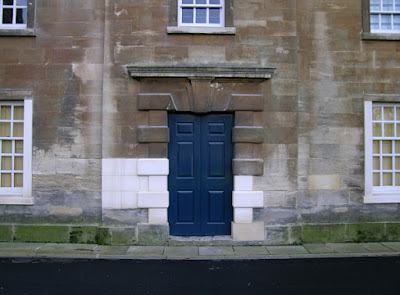After arriving in Cusworth on the No. 41 bus, it took less than half an hour to photograph the listed buildings and other vernacular architecture in the old village and then walk up Cusworth Lane and along Back Lane to the entrance lodge to Cusworth Hall.
Passing through the lodge to its south side, I had a very quick look at the dolomitic limestone ashlar, which will have been quarried from the nearby Cadeby Formation. This has been extensively quarried at Sprotbrough and Cadeby and looking at a weathered and delaminating block, which seems to be face bedded and exposes burrows, it seems more like limestone from the upper Sprotbrough Member than the lower Wetherby Member.
The Grade I Listed Cusworth Hall was built in 1745 by George Platt, for William Wrightson, with alterations by James Paine completed in 1753. It was occupied by the Battie-Wrightson family for more than 200 years, but was sold to Doncaster MBC in 1961 and opened as a museum in 1967.
Approaching the house from the north, two 5 bay service wings face each other across the entrance courtyard. Much of the masonry to the front elevations of these have developed a dark brown patina, as also seen in the house, which is very different to the greyish patina that usually forms on dolomitic limestone from the Cadeby Formation.
This colour reminds me very much of the weathering of Jurassic Bath stone in a polluted urban environment, which I came across very many times while working in the building restoration industry in London. It contrasts strongly with the very pale cream limestone used to restore the west wing, which I first saw back in 2007 when very briefly visiting with the Curator of Natural History at Doncaster Museum, when I was working on the Doncaster Geodiversity Assessment.
When undertaking preliminary research for my day out, I didn’t even think to check the opening times at what is described as a ‘jewel in Doncaster's crown’, especially since I had planned to arrive during the late morning on a Saturday.
Much to my great surprise, I found that the museum was shut – although the current website now shows it as being open on a Saturday – so I just resigned myself to having a quick look around the rest of the exterior and the grounds, which were landscaped by Richard Woods in the 1760’s.
The repairs that I had noticed to the west service block in 2007 are just one part of a major award winning refurbishment that was undertaken at the time, including a complete renovation of the chapel, which James Paine had added together with the library at the opposite end.
Looking closely at the stonework here, the unrestored masonry is quite deeply weathered and exhibits cavernous decay and differential weathering of softer beds, to reveal shallow angle cross-bedding and ripple marks in the limestone.
When used for ashlar masonry or plain walling, limestone from the Cadeby Formation is usually quite resistant to weathering; however, on several buildings that have been restored recently, I have seen marked efflorescence on blocks that are not subject to rising damp and which contributes to accelerated decay, which seems to relate to sedimentary structures within the limestone - as is typically seen in Ancaster freestone, where ripple marks are highlighted by weathering.
Having taken general record photographs of the exterior, without closely examining the stone, I noticed a gate pier where there is a great contrast in the colour and texture between this and the adjoining walling – illustrating some of the physical differences between the lower and upper members of the Cadeby Formation.
The lower cream to yellowish coloured Wetherby Member tends to be oolitic and shelly, with well defined massive beds that are often associated with bryozoan reefs, as seen at North Cliff Quarry in Conisbrough. The Sprotbrough Member, which is well exposed at Warmsworth Park, displays large scale cross-bedding, a greater degree of dolomitisation that has obliterated the primary texture and fossils and tends to be much paler in colour.
Before following a path to the Upper Fish Pond, I stopped to look at the view towards Doncaster, where there is a rapid fall in the elevation of the land beyond the South Don Fault, which separates the limestone of the Permian Brotherton Formation and the mudstones of the Roxby Formation. The lower ground, which also includes the Triassic Chester Formation, is largely covered in Quaternary river terrace deposits and alluvium laid down by the River Don.
I carried on down the path to the north end of the Upper Fish Pond to photograph the Grade II Listed boathouse, which is probably part of Richard Wood’s landscaping in 1763 and is in the form of a grotto constructed with limestone boulders and rubble.















No comments:
Post a Comment